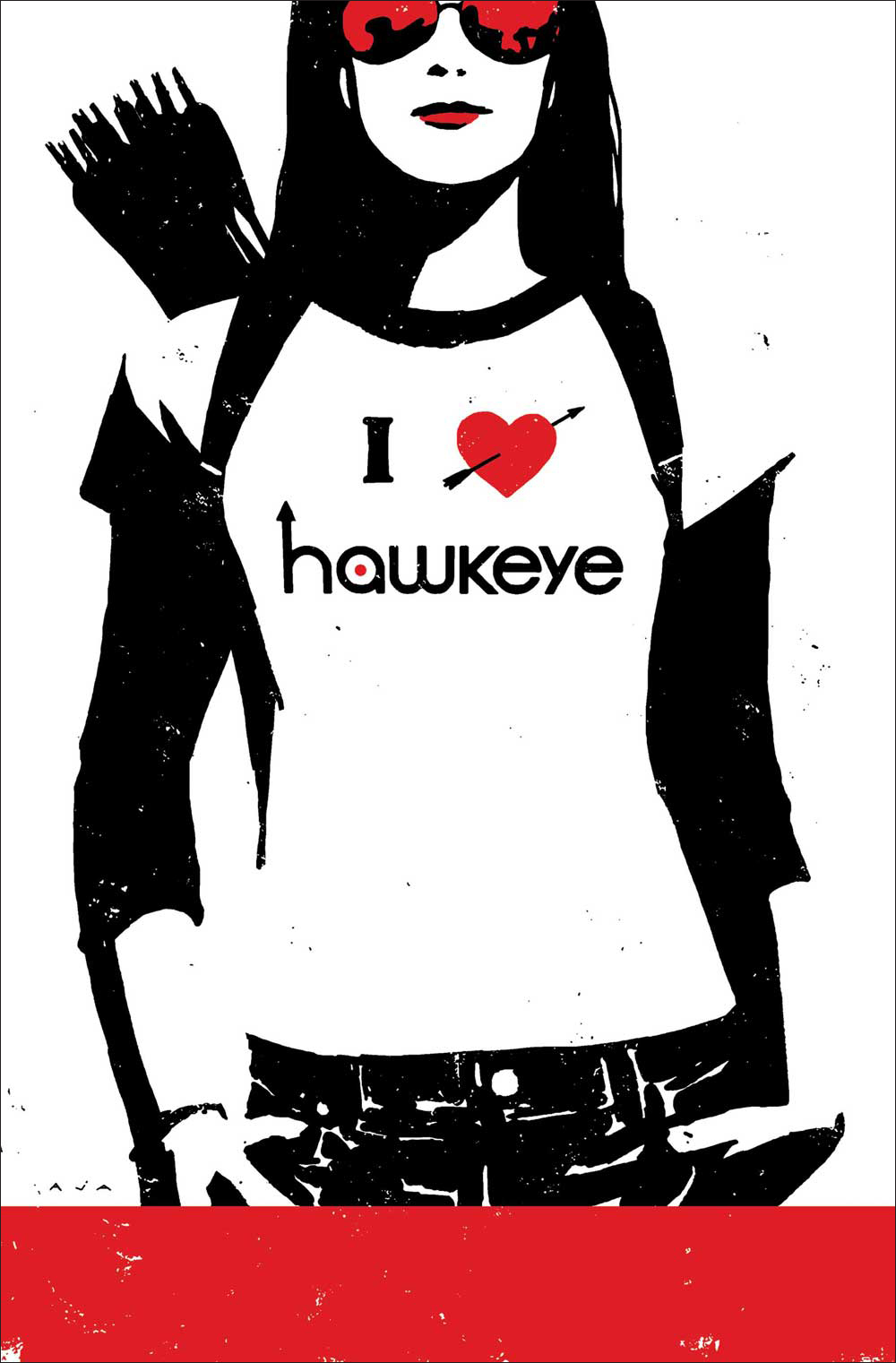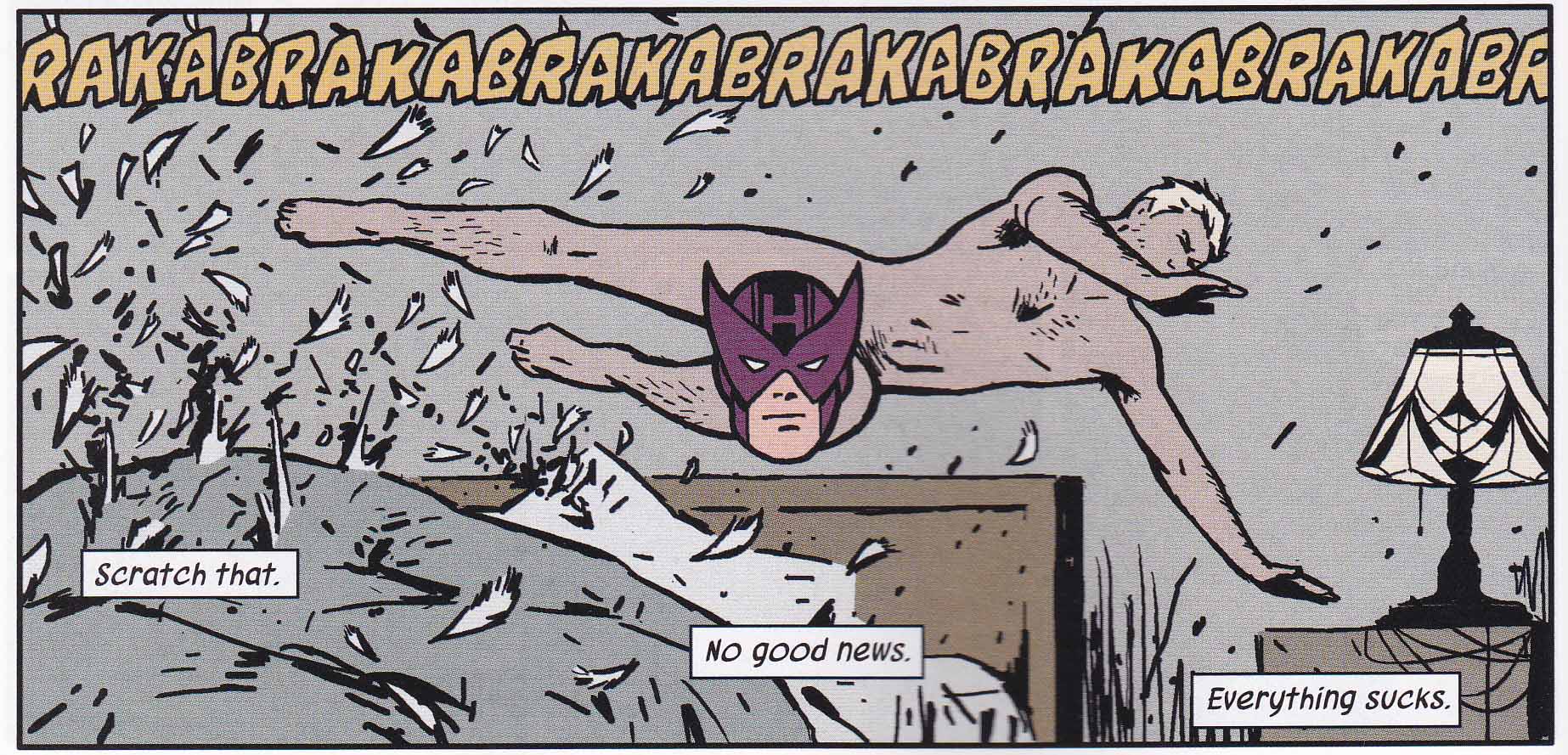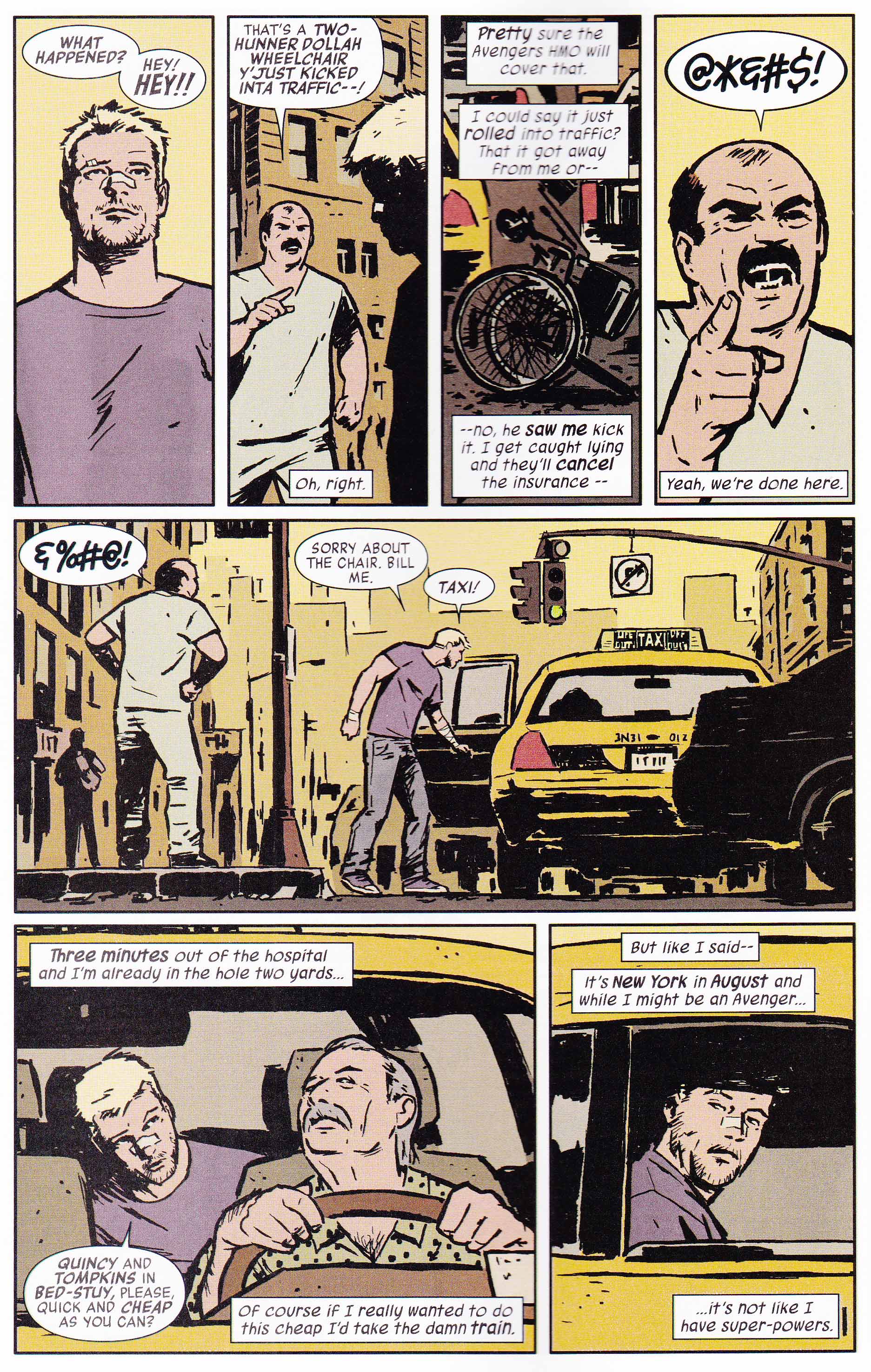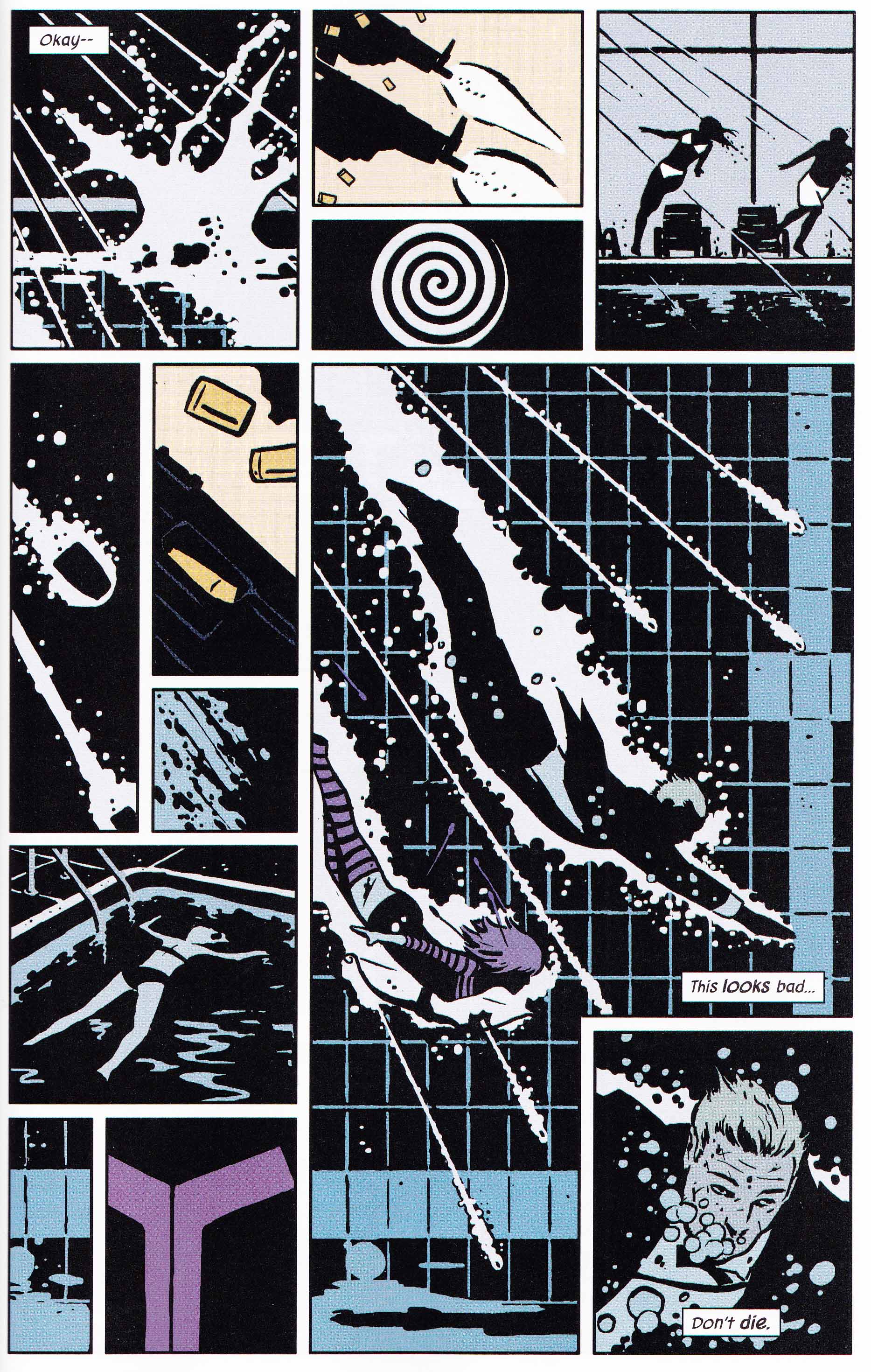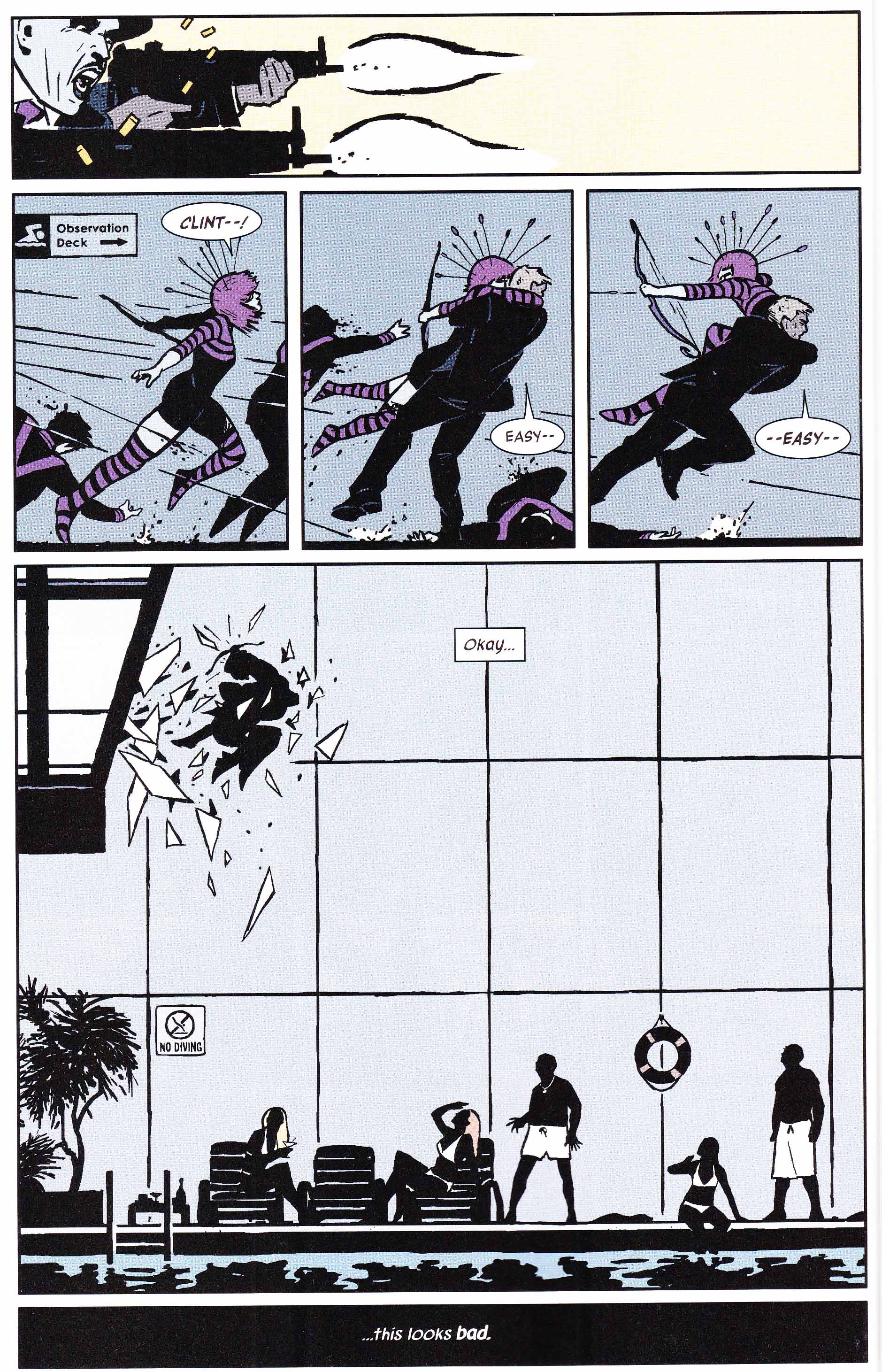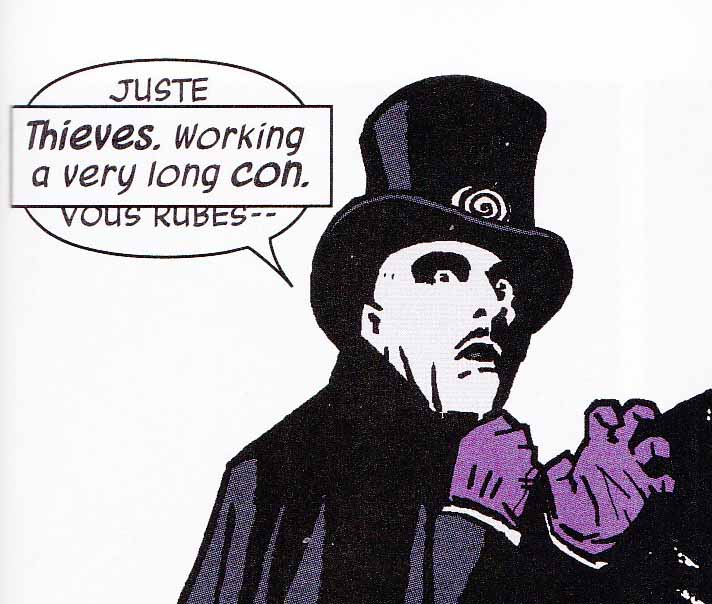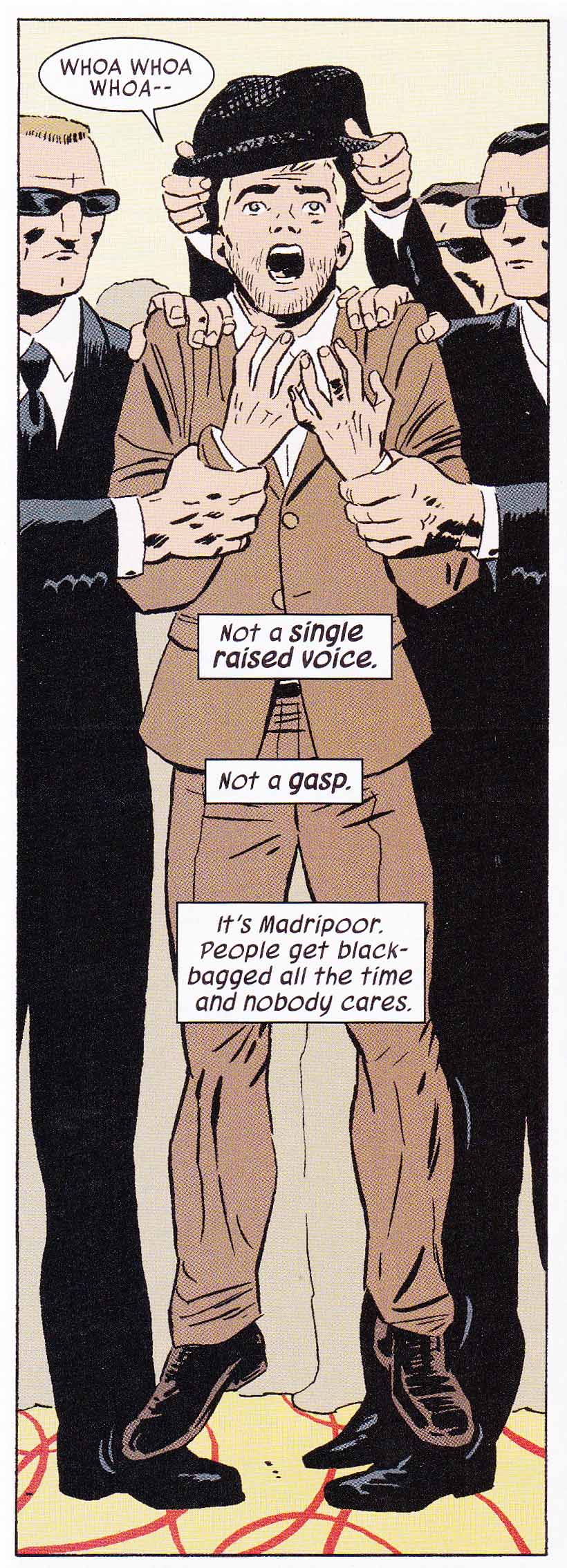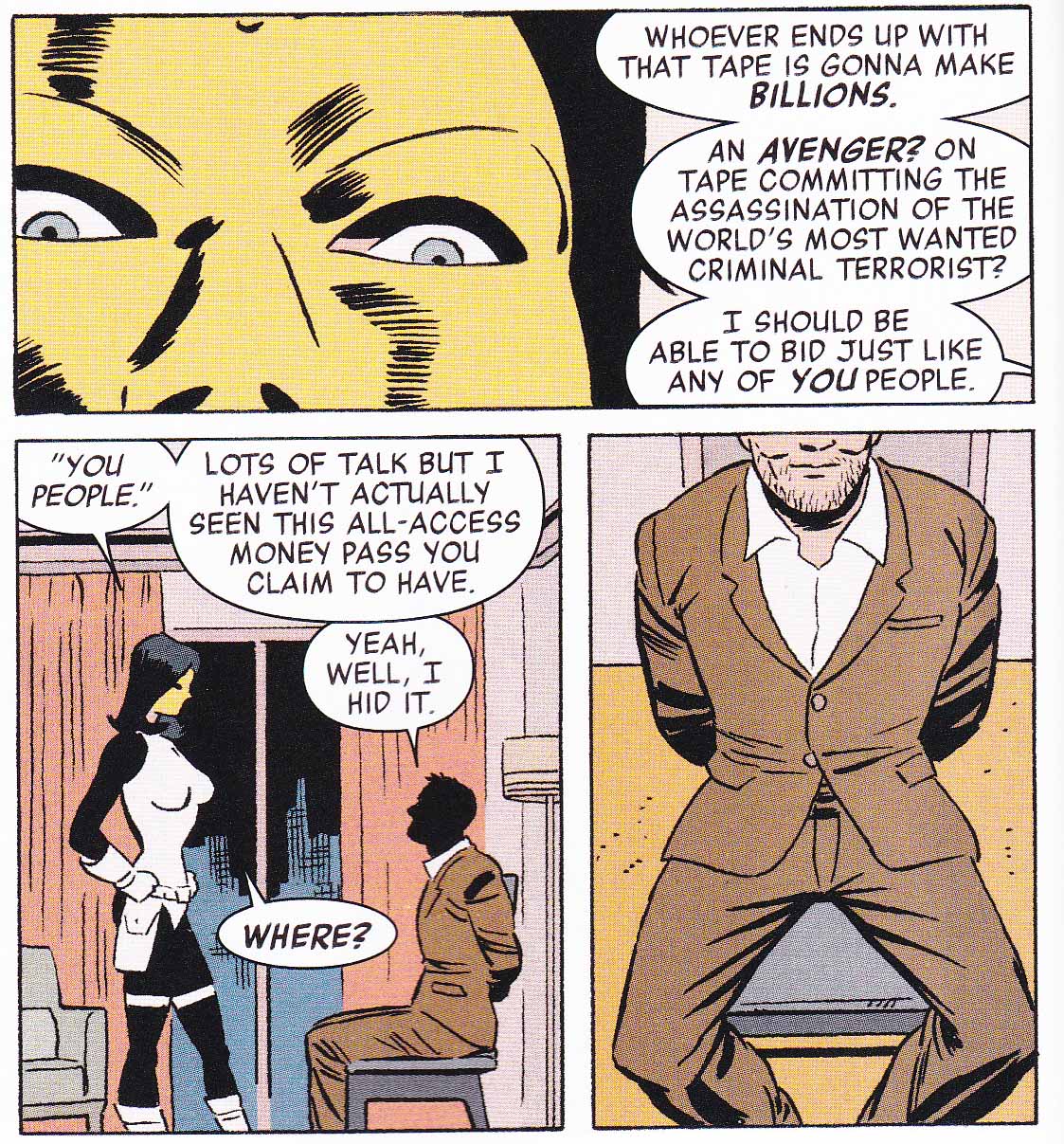Hype always works on me
Even when I know the ultimate source of it all is as sick as a demented chimpanzee, I still get sucked into it. The straw which finally broke the proverbial camel’s back this time round was a host of Eisner nominations by a group of esteemed judges: Best Continuing Series, Best New Series, Best Writer, Best Penciler/Inker, and Best Cover Artist.
I managed to avoid every single review of Matt Fraction and David Aja’s Hawkeye so as not to contaminate my ultimate pleasure in reading it. But there were still some whispered rumors that managed to creep through; that this wasn’t your usual superhero comic; that there was some new method at work, some new insight into the genre. And the first three issues of Hawkeye do hold that line to some extent.
It is possible to see an attempt to move away from the usual strictures of the superhero form, a settled and ceaselessly visited structure which has provided the template for most of the “classic” superhero storylines since the 1980s—the world or the superhero’s existence in great peril.
We see this in Daredevil: Born Again where a way of life is extinguished and The Dark Knight Returns where age is the great antagonist. The world is collapsing in Watchmen and that supreme god of goodness is taking his final steps in Alan Moore and Curt Swan’s Last Superman Story. Frank Miller and Bill Sienkiewicz’s Elektra: Assassin seems to break this pattern—the world is never really in danger of being nuked, the heroine enigmatic and never in any real danger; the ultimate premise being to watch Elektra fuck every person in existence to hell. Just one of Miller’s many wet dreams which he decided to share with us all.
The glue which binds most of the superhero “classics” of the late 80s is that atmosphere of persistent oppression, a mood thoroughly rejected by Grant Morrison in his take on Superman a decade later. But much earlier than that, J. M. DeMatteis, Keith Giffen, and Kevin Maguire were reimagining the Justice League as a sitcom in a series which still manages to strike a nostalgic twinge in a few older readers. Maguire’s facility with facial expressions was the foundation of that effort, and the new Hawkeye holds strongly to that sense of comedy though it has a different shtick: there’s the penile obstruction (a sly suggestion to those who would name their genitalia after superheroes)…
…the metafictional digs at language perception; and the fact that all the baddies have a penchant for the word “Bro” (among other things).
David Aja is the dominant partner in this collaboration, especially when it comes to the look and feel of the comic; showing enough chops to take on the mantle cast upon the closet drawer by David Mazzucchelli when he left superhero comics for good. If you don’t sense the evocation of late issue Born Again and Batman: Year One in the following page, then God help you.
The first page of the second issue shows that it wasn’t a fluke when Aja worked with Ann Nocenti on “3 Jacks.”
Fraction and Aja strip out the elements of a single action sequence: the symbols which mark the villains and the heroes; the graceful diagonals of the page broken into small panels and moving from left to right; the bodies swaying in a danse macabre; the twins guns ringing out like a silent soundtrack; an evolved form of Steranko stylishness and page breakdown. It’s all as sweet as the candy which J. H. Williams III used to lace his Batwoman in times past. You and I could care less about the story.
But there it is, weaved thoroughly into the mythos of the Marvel empire. Right from the start, we get the hints and the nods, the insider knowledge needed for the insider fun. The ability to link descriptions of the Avengers with their likenesses and their names; the ability to identify a Marvel rogues gallery; the ability to know who Iron Fist is (and that Fraction and Aja once worked on the character); the ability to thrill at the sight of a third string villain like the Ringmaster because you read The Incredible Hulk and Steve Ditko’s Amazing Spider-man as a kid; the ability to actually care who these people are.
The Ringmaster’s stage is a homage to The Cabinet of Dr. Caligari (the third issue pulls in The Italian Job) and Aja’s action scenes are consistently stylish…
…the spell broken only by the words and ideas. The second issue seems as well plotted as television’s Arrow, the youth oriented, touchy-feely version of Green Arrow. When Clint Barton (aka Hawkeye) thinks, “Thieves. Working a very long con,” you wonder whether you missed anything apart from the obvious, television-lite set-up which preceded the unveiling of a forgettable super villain. Those expecting Mamet-like moments of intrigue following on those words will be sorely disappointed.
Barton in these issues is a bit like Chandler’s Phlilip Marlowe without the cool dialogue, machismo, and active mind—he’s basically a plains clothes knight of the city who gets beaten up a lot. He uses fists not words and is bereft of any trace of deep intellectual content or motivation. He’s just another nice guy in an unending stream of nice guys in popular culture. He never dies; no, he can’t die because no one actually wants to kill him. They just want to tell him that he’s going to die like every weirdo in the Marvel universe. If readers came here even remotely excited that this was a comic which takes the superhero into hitherto unknown territory, let me dampen that down right now.
The excitement here is that Hawkeye doesn’t wear his costume all that much and acts like a real life human being once in a while. He cracks some jokes and has some sense of his own mortality when he or his friends get shot at. He is hopeless at superheroics (i.e. fallible). He also has to make rent for his poor neighbors, just like a rich Peter Parker would do (except that, you know, Spider-man was poor). Also, he gets to hang out with a bunch of babes. The bar has been lowered to the level of a Munchkin.
The collected Hawkeye (which reprints #1-5) helps us ascertain where Matt Fraction ends and David Aja begins. Issues 4 and 5 of Hawkeye remain as empty of story interest as issues 2 and 3 but stand in stark contrast due to the absence of Aja. Javier Pulido stumbles hard in his first issue and Clint Barton comes out looking like a paper doll in parts.
Pulido retrieves a bit of his dignity in some of the action sequences in issue 5.
That fifth issue did make me read up a bit on Operation Eucritta (say this with a Southern accent if you will). Apparently it’s this:
“An Avenger? On tape committing the assassination of the world’s most wanted criminal terrorist?”
Hawkeye has to retrieve this tape before it’s released to a mass audience of baddies assembled at a private auction in Madripoor.
Before confirming the real line of reasoning behind this plot, I had imagined that it would be just bad PR all round for an Avenger to be seen killing the Marvel Universes’ equivalent of Osama bin Laden, one Du Ke Feng. Of course, doing the same has been such excellent business for President Obama that he’s decided to extend the program to any Tom, Dick, or Harry acting suspiciously. So out with that!
The Marvel database tells us that the Avengers doing the assassinating were Captain America, Wolverine, and Hawkeye; except that those tapes were fakes created to obscure the identities of a bunch of Navy SEALs (the real hit team) and to flush out a spy in SHIELD. Hawkeye has to prevent the auctioning of his personal tape (lost accidentally) because it would put his life in danger.
What?
People need an excuse to kill Cap, Wolvie, and Hawkeye? I thought supervillains did this for free every day of the week but mostly on shipment days? I think they usually arrange to destroy the universe at least once a year as well. No extra charge.
The end of issue 5 is where superhero fantasy meets “real” life, a special corner of heaven where Fraction becomes as solemn as Denny O’Neil in his Green Arrow drug issue:
“The guys that actually did this — they’re doing what they think is right. They didn’t sign up to get their families and friends killed as retribution.”
Except in real life, the terrorists, freedom fighters, and soldiers attached to the individuals assassinated don’t need names to enact “retribution.” They simply kill and maim the soldiers and citizens of the offending nation(s)—a simple and evident fact that is erased in favor of platitudes and cameos by the Kingpin and Nick Fury. In this make-believe world where bad men practice evil for indefinable or ridiculous reasons, violence becomes necessary and inconsequential. The only reasonable answer to violence is more violence.
The new Hawkeye comic is barely acceptable to aging fans and a thorough going embarrassment to those who have promoted its excellence. I would liken it to going back to a middling diner you haven’t been to in decades and discovering that they’ve changed the uniforms. The food? Probably just as bad as ever.
_______
Further Reading
Sean Collins on Hawkeye #2-3
“…it feels like Matt Fraction poured a bunch of unrelated ideas into a Hawkeye-shaped vessel because that’s what was available. I’m not saying there’s some One True Hawkeye out there, I’m saying I don’t think Hawkeye, One True or otherwise, is anything but an extraordinarily flimsy frame on which to hang surface-cool writing like this.”
Tucker Stone on the first issue of Hawkeye.
The Comic Books Are Burning in Hell gang thinking out loud on the possible reasons for the prodigious levels of adulation heaped on the comic (starts around 19 min).
David N. Wright at Graphixia – “Hawkeye and the Problem of Comics as Art.” Comparing a later issue of Hawkeye (not reviewed above) to the work of Chris Ware. The real kicker comes at the end. Doesn’t this all sound rather familiar:
“Fact is, comics stand in relation to art like the internal combustion engine stands in relation to the steam engine: they may well be andecendants, but to think of them in this way does nothing to help us understand either. That comics are often a collaborative, usually repetitive, almost always recycled endeavour opens spaces for new conversations about the nature of the medium. These conversations must occur outside the already established aesthetic principles of artistic production in precisely the same way that a discussion of the steam engine must stand outside a discussion of an internal combustion engine. Comics are a multi-mediated and re-mediated form of practice and cultural production that can only be defined within its own contexts—a context that more than justifies its significance as the most relevant form of twenty-first century aesthetic practice—and that means it can’t be art or Art… or, mercifully, stand in relation to either.” [emphasis mine]

